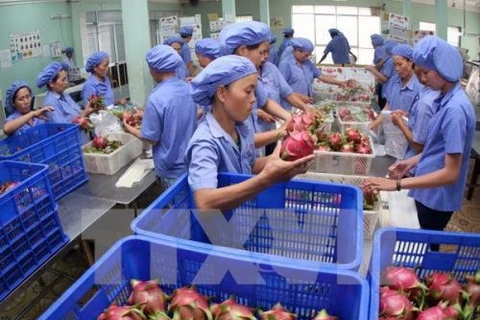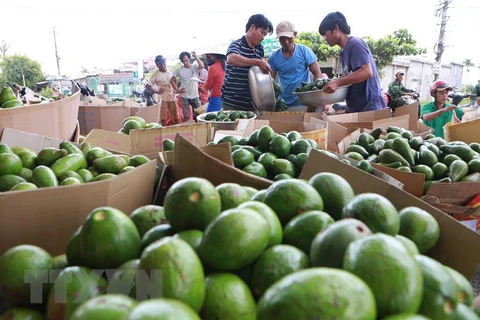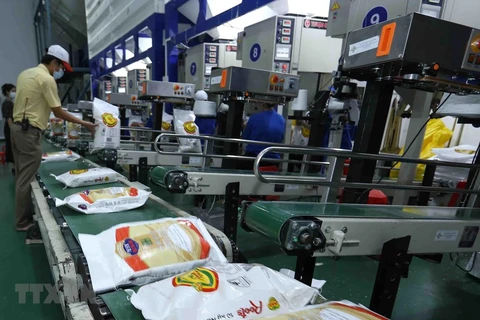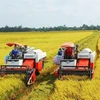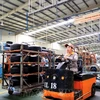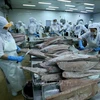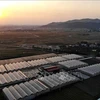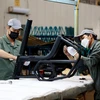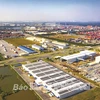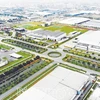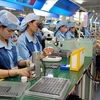Hanoi (VNA) - To bring goods to modern retail systems, agricultural production facilities need to meet all requirements such as business registration, food safety and hygiene, and test papers.
Bringing goods to major distribution channels in high and stable volume is the goal of local enterprises, cooperatives and farmers.
In Vietnam, thanks to good natural conditions, farm produce is abundant and diverse. However, many kinds of farm produce are tough to sell and lack access to modern distribution channels.
Lack of handshake?
According to the Ministry of Industry and Trade (MoIT), supply-demand connectivity and helping enterprises bring good quality products to the supply chain have brought about positive results.
The total retail of goods and services has hiked about 10 percent annually since 2009. In particular, after a decade of the "Vietnamese people prioritise Vietnamese goods" campaign, Vietnamese goods have flooded foreign supermarkets in Vietnam such as Lotte (82 percent by revenue and 84 percent by volume), Big C (96 percent by revenue) and AEON (80 percent by product code).
Deputy Director of the Ministry of Industry and Trade’s Domestic Market Department Le Viet Nga said the impressive figures show the efforts of the Association of Vietnam Retailers and its members, as domestic goods face fierce competition from imported ones.
Hoang Van Kham, Director of the Chuc Son clean fruit and vegetable cooperative in Hanoi’s outlying district of Chuong My, said its vegetables and fruits are mostly supplied to Big C and Vinmart supermarkets, major hospitals and schools in the capital city.
Thanks to joining safe a farm produce supply chain, the cooperative's trademark is increasingly welcomed by consumers.
From another perspective, Pham Ngoc Thanh, Director of the Phuc Lam Development Consultancy and Trading JSC in Phu Lam ward, Hanoi’s Ha Dong district, said businesspeople all want high profits but retailers need to share with producers.
“Supermarkets’ high discount rates have pushed up the prices of Vietnamese farm produce, making it hard for them to compete with imported goods. Therefore, producers expect support from retailers to prevent their products facing other difficulties after overcoming the inspection stage,” he said.
- The rate of Vietnamese goods in several foreign supermarkets in Vietnam
Producers need to be more professional
Despite connectivity programmes between firms and localities to facilitate consumption, major businesses earn success mostly from the application of technologies.
Vice versa, spontaneous and unprofessional business is one of the main reasons for slow sales.
Tran Thi Phuong Lan, Deputy Director of the Hanoi municipal Department of Industry and Trade, said domestic farm produce struggles to enter supermarkets because many producers have yet to ensure the quality of goods in line with supermarkets’ standards.
In fact, many products have yet to ensure food hygiene and safety standards, and even lack barcodes and have only simple packaging.
To bring goods to modern retail systems, Vice Executive Chairwoman of the Central Group Le Thi Mai Linh said producers and farmers need to prepare business registration licenses, food hygiene and safety certificates, quarantine papers, price quotes and samples.
Retailers will inspect goods and decide if they meet standards to enter supermarkets.
“With these conditions, businesses, cooperatives, and farmers must change their production methods in a more stable and professional manner. If working closely with retailers, producers will know how to adjust production,” she said.
To form effective connectivity between businesses, farmers and cooperatives, concerned authorities must help facilitate sustainable growth.
Nga said the Ministry of Industry and Trade has come up with many projects between now and 2020 to arrange distribution in remote and mountainous areas and offer training courses for business households to distribute Vietnamese goods.
However, the core measures are to improve product quality and offering reasonable prices, especially in rural areas.-VNA



